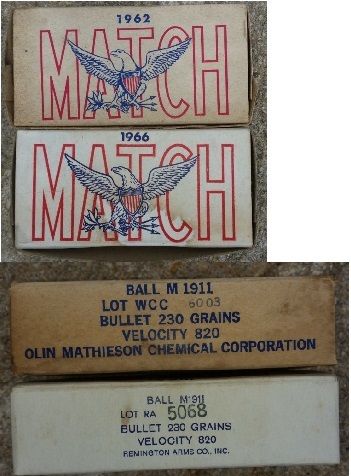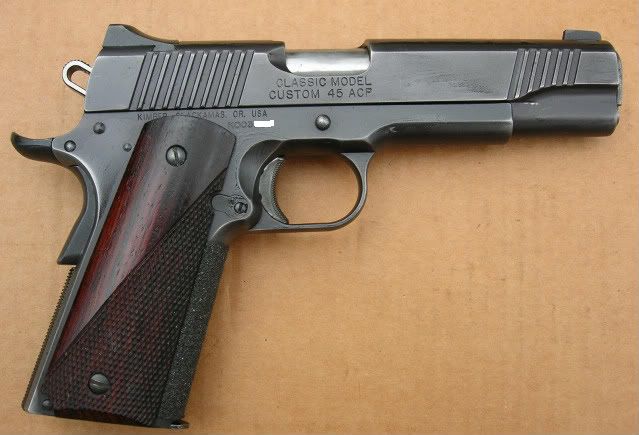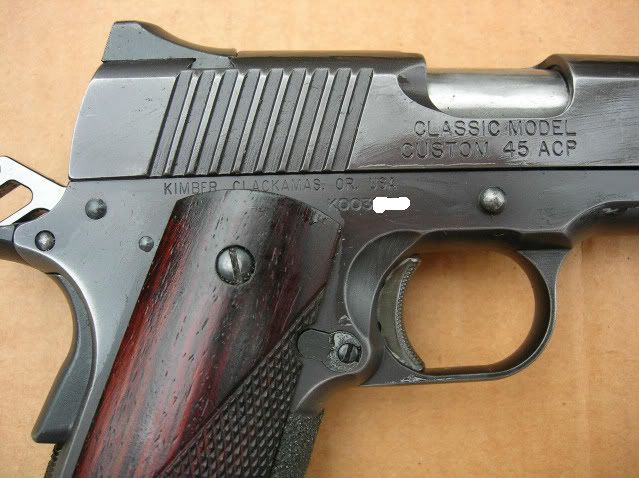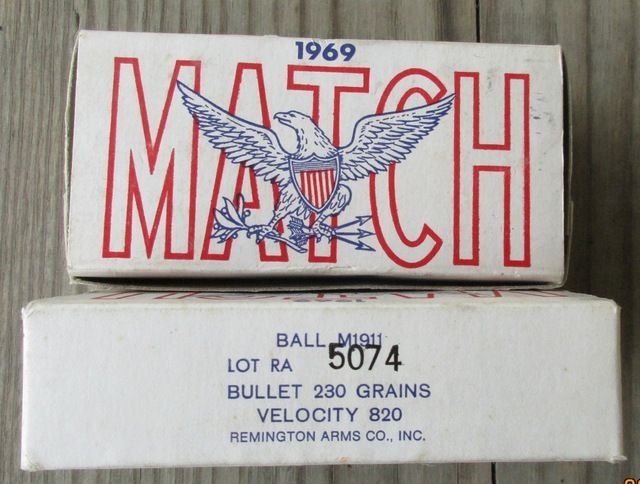You are using an out of date browser. It may not display this or other websites correctly.
You should upgrade or use an alternative browser.
You should upgrade or use an alternative browser.
USGI Service Load for the 1911A1?
- Thread starter Sea Buck
- Start date
The closest I have to the GI specs is this,
Cartridge, Caliber .45, Ball, 1911
Velocity: 855fps +/- 25fps at 25.5 feet
Pressure: 19,000psi, max avg
Accuracy: 7.46" diagonal (max avg) at 50 yards
Cartridge: 311-17gr
Case: 87 -10 gr
Bullet: 234-6gr copper alloy. 231gr guilding metal clad steel
Propellant: SR7970, single base, flake, 5gr.
HPC-1, double base, flake, 5grs,
Point identification: Plain Tip
Hope this helps.
Cartridge, Caliber .45, Ball, 1911
Velocity: 855fps +/- 25fps at 25.5 feet
Pressure: 19,000psi, max avg
Accuracy: 7.46" diagonal (max avg) at 50 yards
Cartridge: 311-17gr
Case: 87 -10 gr
Bullet: 234-6gr copper alloy. 231gr guilding metal clad steel
Propellant: SR7970, single base, flake, 5gr.
HPC-1, double base, flake, 5grs,
Point identification: Plain Tip
Hope this helps.
Once the dust settled from all the arguing(Winchester, Frankford Arsenal and Union Metallic Cartridge, et al) the first issue ammo for the 1911 was a 230 at 850 fps. The 200 grainer was in the 1905 pistol.
Bullseye won't give you 850 fps with a jacketed bullet. Max loads with a TMJ are close. (Copper Plated RN's are not jacketed bullets.) There are a bunch of Hodgdon powders that will though.
Bullseye won't give you 850 fps with a jacketed bullet. Max loads with a TMJ are close. (Copper Plated RN's are not jacketed bullets.) There are a bunch of Hodgdon powders that will though.
A box I saw of old (1920's) FA ball said 230 grains and 825 fps and states that is was loaded with Bullseye powder. The newer military tech manuals say 234 grains and 885 fps +/-25 fps, as measured at 25.5 feet from the muzzle. That would be about 889 fps at 15 feet from the muzzle, the standard SAAMI distance. The old load was roughly 350 ft-lbs (347 if you are picky), like commercial hardball usually is, vs. the more modern load at 400 ft-lbs. I suspect the change was made because that brought 1911 ball up to the muzzle energy of 9 mm 115 grain ball.
The modern military load uses a nominal 5 grains of SR 7970, a powder I've not seen available as new powder on the civilian market. 5 grains of Bullseye is the old standby that gets you to the 850 fps range. However, according to their load manual data, Accurate Solo 1000 comes very, very close to the same performance as 7970 and might be the powder to try here.
One thing to keep in mind about the military bullet is that it has a long, elliptical ogive profile, giving it 0.68 inches of length, where most commercial ball is more hemispherical at the tip, so its shorter, with 0.65-.655 being common numbers (Hornady and Sierra, respectively). Most military ball ammo I've measured is about 1.270" COL. So 1.240"-1.245" would give you the same seating depth for the commercial bullets.
The modern military load uses a nominal 5 grains of SR 7970, a powder I've not seen available as new powder on the civilian market. 5 grains of Bullseye is the old standby that gets you to the 850 fps range. However, according to their load manual data, Accurate Solo 1000 comes very, very close to the same performance as 7970 and might be the powder to try here.
One thing to keep in mind about the military bullet is that it has a long, elliptical ogive profile, giving it 0.68 inches of length, where most commercial ball is more hemispherical at the tip, so its shorter, with 0.65-.655 being common numbers (Hornady and Sierra, respectively). Most military ball ammo I've measured is about 1.270" COL. So 1.240"-1.245" would give you the same seating depth for the commercial bullets.
disseminator
New member
With a Rainier 230 grain round nose bullet seated to 1.25" COAL I use 6 grains of vvN340 for 880fps/395ftlb
I also have a load for the same bullet and seating depth but use 7.2 grains of Hodgdon LONGSHOT instead for 883 fps/398 ftlb
Both those are standard pressure (non +p) and shoot great in all my 45's.
I used to go to 1.27" OAL but my SIG (P227) would choke on them so I went to 1.25" and all is well.
I also have a load for the same bullet and seating depth but use 7.2 grains of Hodgdon LONGSHOT instead for 883 fps/398 ftlb
Both those are standard pressure (non +p) and shoot great in all my 45's.
I used to go to 1.27" OAL but my SIG (P227) would choke on them so I went to 1.25" and all is well.
Jim Watson
New member
There was a period of time when commercial .45 ACP was listed at 810 fps.
I was told that the ammo had not changed but that the commercial lab testing differed from military. Now we are shown hotter rather than milder.
I was told that the ammo had not changed but that the commercial lab testing differed from military. Now we are shown hotter rather than milder.
Marco Califo
New member
www.alliantpowder.com
230-gr Speer TMJ RN
Bullseye
CCI 300
Speer
1.260
5.7
840
You can get 100+ fps more with modern powders. Bullseye was the original powder used.
Note: You will find that load in the 2017 Alliant Reloading Guide PDF which can be downloaded from the http://www.alliantpowder.com/resources/catalog/2017/2017_Alliant_Powder.pdf . However, if you use the on-line version of the guide http://www.alliantpowder.com/reloaders/default.aspx, that load will not display there. Alliant is slightly less forth coming about older powder loads, and features their newer powders (BE-86 and now Sports Pistol) in the on-line version. Yet all the above are 2017 publications.
Older Alliant and Hercules load pamphlets can be accessed here: http://www.castpics.net/LoadData/Freebies/RM/Alliant.html
These older pamphlets have loads for Bullseye, Red Dot , Green Dot, Herco in many pistol calibers. Alliant will email complete load data to you on request for a specific caliber. I found these to be the exact same as the older data for shotgun powders in pistol loads.
230-gr Speer TMJ RN
Bullseye
CCI 300
Speer
1.260
5.7
840
You can get 100+ fps more with modern powders. Bullseye was the original powder used.
Note: You will find that load in the 2017 Alliant Reloading Guide PDF which can be downloaded from the http://www.alliantpowder.com/resources/catalog/2017/2017_Alliant_Powder.pdf . However, if you use the on-line version of the guide http://www.alliantpowder.com/reloaders/default.aspx, that load will not display there. Alliant is slightly less forth coming about older powder loads, and features their newer powders (BE-86 and now Sports Pistol) in the on-line version. Yet all the above are 2017 publications.
Older Alliant and Hercules load pamphlets can be accessed here: http://www.castpics.net/LoadData/Freebies/RM/Alliant.html
These older pamphlets have loads for Bullseye, Red Dot , Green Dot, Herco in many pistol calibers. Alliant will email complete load data to you on request for a specific caliber. I found these to be the exact same as the older data for shotgun powders in pistol loads.
Last edited:
The Federal 185 grain Hydra-Shok produces 1130 fps and 524 ft-lbs. Once you start going to modern powders and projectiles you are in a different arena. A civilian load can do much more impressive things than standard hardball. Even Jeff Cooper, in his last years, was being swayed over to the truncated cone over RN FMJ based on field reports.
I don't know how Winchester White Box 230gn Ball matches up to the original mil-spec ammo.
But just for fun, I did pop open a half-dozen of them and measured 4.5 to 4.6 grains of a propellant that looked a lot - a lot - like TiteGroup.
For whatever that's worth.
My emulation round of WWB is 5.0gn Bullseye, using a 230gn plated RN.
But just for fun, I did pop open a half-dozen of them and measured 4.5 to 4.6 grains of a propellant that looked a lot - a lot - like TiteGroup.
For whatever that's worth.
My emulation round of WWB is 5.0gn Bullseye, using a 230gn plated RN.
The original 1910 cartridge was loaded with a 230 FMJ and 5.0 grains Bullseye. The desired velocity at the time was 800 fps.
This is 1960's National Match ball, and it is only a tiny bit faster.

This load today, with the lots of Bullseye I have tested, comes out just at 800 fps, give or take.
230 gr LRN 4.5 grs Bullseye Mixed Brass WLP
21-Jun-06 T = 97 °F
OAL 1.250" taper crimp .469"
Ave Vel = 805.2
Std Dev =11.4
ES=54.08
High=836.9
Low=782.8
N =32
230 gr FMJ (R-P) 5.0 grs Bullseye 99' & 2005 mixed lot Mixed Brass WLP (brass) OAL 1.265" taper crimp .469"
12-Dec-11 T= 53 °F
Ave Vel = 793.5
Std Dev = 18.92
ES = 61.99
High = 817.4
Low =755.4
N = 16


This is 1960's National Match ball, and it is only a tiny bit faster.

This load today, with the lots of Bullseye I have tested, comes out just at 800 fps, give or take.
230 gr LRN 4.5 grs Bullseye Mixed Brass WLP
21-Jun-06 T = 97 °F
OAL 1.250" taper crimp .469"
Ave Vel = 805.2
Std Dev =11.4
ES=54.08
High=836.9
Low=782.8
N =32
230 gr FMJ (R-P) 5.0 grs Bullseye 99' & 2005 mixed lot Mixed Brass WLP (brass) OAL 1.265" taper crimp .469"
12-Dec-11 T= 53 °F
Ave Vel = 793.5
Std Dev = 18.92
ES = 61.99
High = 817.4
Low =755.4
N = 16


Yes. I think, like a lot of powders, there has been lot variation in Bullseye over the years. Hatcher said 230 grains at 810 fps was the published spec for the Match version of ball ammo during the 1920's. On Page 393 of Hatcher's Notebook he says:
Assuming a BC of 0.18, the MV would have been 821 fps. More than you'd expect from that charge weight.
The pressures would all have been measured by a copper crusher, as they had no piezoelectric transducers in general use in those days. However, with these lower pressure, slow moving rounds, a copper crusher comes pretty close to reading what a modern piezoelectric device does. What is remarkable is the variation. Using a rule of thumb, I'd estimate almost 8%. Twice the allowance SAAMI standards are based on. That's probably limitations in the charge metering of the flake powder showing up.
Also interesting is that the velocity is measured at 25 feet (7.62 m) where the newer TM's show 25.5 ft (7.77 M). No clue when the change might have been made or why. 185 grain Match SWC's are measured at 15 feet from the muzzle according to the TM's I have.
A typical load was that of the 1929 National Match pistol cartridge, which had a charge of 4.7 grain of Bullseye, giving an instrumental velocity at 25 feet of 816 feet per second, with a mean pressure of 14,853 pounds per square inch, and a maximum pressure of 16,533 pounds per square inch.
Assuming a BC of 0.18, the MV would have been 821 fps. More than you'd expect from that charge weight.
The pressures would all have been measured by a copper crusher, as they had no piezoelectric transducers in general use in those days. However, with these lower pressure, slow moving rounds, a copper crusher comes pretty close to reading what a modern piezoelectric device does. What is remarkable is the variation. Using a rule of thumb, I'd estimate almost 8%. Twice the allowance SAAMI standards are based on. That's probably limitations in the charge metering of the flake powder showing up.
Also interesting is that the velocity is measured at 25 feet (7.62 m) where the newer TM's show 25.5 ft (7.77 M). No clue when the change might have been made or why. 185 grain Match SWC's are measured at 15 feet from the muzzle according to the TM's I have.
Even Jeff Cooper, in his last years, was being swayed over to the truncated cone over RN FMJ based on field reports.
Not to hi-jack this thread but what is the difference in a truncated cone (TC) and a flat nose/point (FP) bullet? Or is there any? I've seen/used both but they generally look like the same bullet. Maybe a small difference here and there (possibly the manufacturers...) but I've wondered what is different. Thanks!
A truncated cone is a specific geometry: A cone that has had the sharp tip cut off perpendicular the axis of the cone. It refers to the whole ogive of the bullet, but not the bearing surface below it. Flat point is a less specific term that could be used to refer to any cut off tip, including both the truncated cone and the CAS round flat noses and the various .30-30 bullets. However, some do seem to apply it exclusively to the truncated cone shape. I don't know why.
Personally, I think 'flat tip' would be a better term. 'Flat point' has always struck me as an oxymoron, but it sure gets used a lot. If the flat area is large, the term 'wide meplat' seems to get used instead, but you could argue those are flat tips, too; just big ones.
Personally, I think 'flat tip' would be a better term. 'Flat point' has always struck me as an oxymoron, but it sure gets used a lot. If the flat area is large, the term 'wide meplat' seems to get used instead, but you could argue those are flat tips, too; just big ones.
Personally, I think 'flat tip' would be a better term. 'Flat point' has always struck me as an oxymoron,
Never thought of that but you make a good point. Semantics - ballistics, whatever.
Alliant Powder Data...
In reference to Marco Califo's post, if you look under the products tab on Alliant's site you will see the powder selection of shotgun, rifle, and pistol.
If you select the powder your interested in you will see a link to that powders recipes. Click that link for all data for that particular powder. Just remember to reduce that data by 10% for a start load as what's listed is a max for that powder bullet combo.
I use both Bullseye and Unique for my 230'ish grain loads with BE getting the majority of them. I use cast, plated, and jacketed with the same load of 4.8grs and they shoot great.
In reference to Marco Califo's post, if you look under the products tab on Alliant's site you will see the powder selection of shotgun, rifle, and pistol.
If you select the powder your interested in you will see a link to that powders recipes. Click that link for all data for that particular powder. Just remember to reduce that data by 10% for a start load as what's listed is a max for that powder bullet combo.
I use both Bullseye and Unique for my 230'ish grain loads with BE getting the majority of them. I use cast, plated, and jacketed with the same load of 4.8grs and they shoot great.
Bullseye won't give you 850 fps with a jacketed bullet.
??
I have reloading manuals that say otherwise. And considering the exact same ammo can give you 830fps in one gun and 870fps in another I don't think such a broad statement is accurate.
Care to add some qualifying specifics?
Yes. All the National Match seems to be a little slower than combat ball. However, I think the OP is after the latter.
44AMP,
If you peruse Mr. O'Heir's past posts and my responses to them, you will find he is a frequent poster of authoritatively stated "facts" that aren't so, mixed in with ones that are. I don't think he reads responses to his posts much, as I've directed him to articles disproving some of his erroneous "facts" only to see he repeats them later in other threads.
44AMP,
If you peruse Mr. O'Heir's past posts and my responses to them, you will find he is a frequent poster of authoritatively stated "facts" that aren't so, mixed in with ones that are. I don't think he reads responses to his posts much, as I've directed him to articles disproving some of his erroneous "facts" only to see he repeats them later in other threads.
Yes. All the National Match seems to be a little slower than combat ball. However, I think the OP is after the latter.
I am of the opinion, based on discussions with guys who shot the stuff, that NM ammunition was of the same velocity as ball, just better made.
There are all sorts of conflicting velocity information on the web. Some of which comes from TM's which are not reloading manuals. Of the data I can drill down to the factory acceptance level, the velocity data in the TM for 30-06 ammunition was traceable to one pressure barrel at Frankfort Arsenal. Government Acceptance Representatives had cartridges calibrated to that pressure barrel and the test equipment at vendors plants was adjusted to the calibration cartridges. Whatever velocities came out of those calibration cartridges and the Frankford Arsenal barrel were likely different from what would come out of a service rifle barrel. I assume the same for the pistol data in the TM's. Unless someone has proof that the TM pressure barrels were of the same length as M1911 barrels, than the TM higher velocities could be due to pressure barrels of a greater length.

